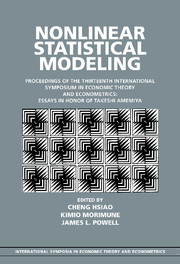 Nonlinear Statistical Modeling
Nonlinear Statistical Modeling Book contents
- Frontmatter
- Contents
- Series editor's introduction
- Editors' introduction
- Contributors
- 1 Local instrumental variables
- 2 Empirically relevant power comparisons for limited-dependent-variable models
- 3 Simulation estimation of polychotomous-choice sample selection models
- 4 A new approach to the attrition problem in longitudinal studies
- 5 Semiparametric estimation for left-censored duration models
- 6 Semiparametric estimation of censored selection models
- 7 Studentization in Edgeworth expansions for estimates of semiparametric index models
- 8 Nonparametric identification under response-based sampling
- 9 On selecting regression variables to maximize their significance
- 10 Using information on the moments of disturbances to increase the efficiency of estimation
- 11 Minimal conditions for weak convergence of the sample standardized spectral distribution function
- 12 Unit root tests for time series with a structural break when the break point is known
- 13 Power comparisons of the discontinuous trend unit root tests
- 14 On the simultaneous switching autoregressive model
- 15 Some econometrics of scarring
- 16 A censored switching regression approach to evaluating the effect of sunk costs and firm-level disequilibrium on export performance
- Curriculum vitae of Takeshi Amemiya
- Index
8 - Nonparametric identification under response-based sampling
Published online by Cambridge University Press: 05 June 2012
- Frontmatter
- Contents
- Series editor's introduction
- Editors' introduction
- Contributors
- 1 Local instrumental variables
- 2 Empirically relevant power comparisons for limited-dependent-variable models
- 3 Simulation estimation of polychotomous-choice sample selection models
- 4 A new approach to the attrition problem in longitudinal studies
- 5 Semiparametric estimation for left-censored duration models
- 6 Semiparametric estimation of censored selection models
- 7 Studentization in Edgeworth expansions for estimates of semiparametric index models
- 8 Nonparametric identification under response-based sampling
- 9 On selecting regression variables to maximize their significance
- 10 Using information on the moments of disturbances to increase the efficiency of estimation
- 11 Minimal conditions for weak convergence of the sample standardized spectral distribution function
- 12 Unit root tests for time series with a structural break when the break point is known
- 13 Power comparisons of the discontinuous trend unit root tests
- 14 On the simultaneous switching autoregressive model
- 15 Some econometrics of scarring
- 16 A censored switching regression approach to evaluating the effect of sunk costs and firm-level disequilibrium on export performance
- Curriculum vitae of Takeshi Amemiya
- Index
Summary
Introduction
Consider a population each of whose members is described by a vector of covariates z and a binary response y. A common problem of empirical research is to infer the conditional response probabilities P(y|z) when the population is divided into response strata and random samples are drawn from one or both strata. This sampling process is known to epidemiologists studying the incidence of disease as case-control, case-referent, or retrospective sampling, and has been prominent in epidemiological research since the work of Cornfield (1951). The same sampling process in known to economists studying individual behavior as choice-based sampling (Manski and Lerman 1977) or as responsebased sampling (Manski 1986). The final synonym will be used here.
Sampling from the stratum with y = 1 reveals the distribution P(z | y = 1) of covariates within this stratum. Sampling from the stratum with y = 0 reveals P(z | y = 0). So response-based sampling raises this basic inferential question: What does knowledge of P(z | y = 1) and/or P(z | y = 0) reveal about P(y | z)?
Analysis of response-based sampling has concentrated on situations in which the empirical researcher is able to draw random samples from both response strata, and thus learns both P(z | y = 1) and P(z | y = 0). The epidemiological and econometrics literatures have emphasized the identifying power of auxiliary information on the distribution of response and covariates. These literatures have, however, differed in important ways.
- Type
- Chapter
- Information
- Nonlinear Statistical ModelingProceedings of the Thirteenth International Symposium in Economic Theory and Econometrics: Essays in Honor of Takeshi Amemiya, pp. 241 - 258Publisher: Cambridge University PressPrint publication year: 2001
- 1
- Cited by
